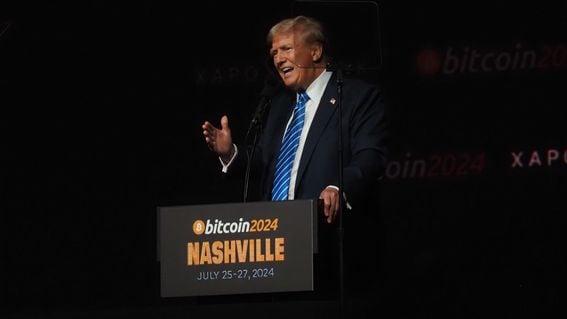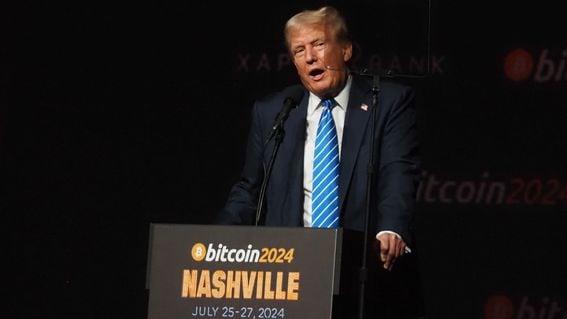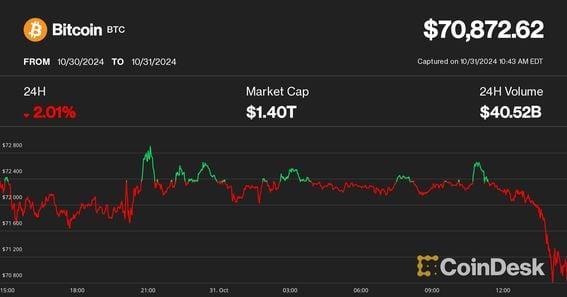2024-11-01 06:40
He has recommended that the state retirement system direct a portion of its funds into crypto. Patronis recommended for the state’s retirement fund to diversify into cryptocurrencies earlier this month. But he’s also raised concerns about government overreach through central bank digital currencies. Florida already holds about $800 million in crypto-related investments in its portfolio, but the state’s Chief Financial Officer Jimmy Patronis said he would “not be shocked to be able to see that growing under a Trump administration in the near future.” Patronis hit out at crypto skeptics during a CNBC interview on Thursday, saying that those not paying attention to crypto were making a “mistake” and suggesting that Miami could become the “crypto capital of the world”. He has also recommended that the state retirement system direct a portion of its funds into crypto. “I’m going to continue to push forward to make sure that we're doing everything possible to take advantage of this. It's not emerging, it's here,” he said. “I need to make sure that we're doing everything humanly possible to get [state employees] the best return on their investment. And if we're not being open minded to what crypto could do to diversify that portfolio, shame on us.” Other U.S. states have also looked into cryptocurrency investment, including Wisconsin and New Jersey. Trump has floated the idea of a national crypto stockpile if elected president. Patronis also raised concerns about the potential of a Central Bank Digital Currency (CBDC) in the U.S. “We need to be able to have a hedge against this massive overreach by the federal government with a centralized currency,” he said. “I don't want the federal government knowing that my son went to the grocery store to go buy a bag of Doritos at 2:15 in the afternoon. We need to have some protections in place.” https://www.coindesk.com/policy/2024/11/01/florida-cfo-jimmy-patronis-would-not-be-shocked-to-see-states-800m-crypto-portfolio-grow-under-a-trump-presidency-cnbc/

2024-11-01 05:03
CoinDesk had 20 minutes in person with the Tron founder on the sidelines of Chainlink's Smartcon at Hong Kong Fintech Week. We covered a lot. In an interview with CoinDesk, Justin Sun explained why memecoins are more fair than VC-backed tokens, how traders are having better memecoin returns on HTX rather than Binance, and the importance of bringing Chainlink to Tron's DeFi ecosystem. He also said that he has a slight preference for dog memecoins rather than cat memecoins. Research from CoinGecko shows there's a market preference for cats over dogs. HONG KONG – Getting a sit-down interview with Justin Sun is a difficult process. Logistics are coordinated at the same scale as if he were a head of state, and Sun's schedule at a conference is organized down to the minute. Booking Sun requires a secure room; there were visits by advance teams to walk through it and a sweep from security. When he arrived, there was an entourage, including guards, to push onlookers out of the way CoinDesk got 20 minutes with Sun on the sidelines of Chainlink's SmartCon during Hong Kong Fintech week to talk about everything from why memecoins are more fair than VC-backed tokens, as well as why Chainlink is bringing more TradFi to Tron. Along the way we asked if he's a dog or a cat person, as the memecoin market demands. This interview has been edited and condensed. On the fairness of memecoins CoinDesk: Do you think memecoins are more fair than venture-capital-backed tokens? There's been plenty of criticism on how these tokens only enrich the elites and leave retail traders diluted. Sun: Fair launch is one of the biggest advantages of meme coins. Everyone can track the tokens, and if anyone moves large amounts of assets without the community knowing, the price will drop significantly. We’ve seen instances called "rug pulls" when this happens. Fair distribution and fair launches are key. I tell memecoin developers on Tron that if they want to be at the top, they need to ensure fair launch and distribution. CoinDesk: There has been a shift in market structure with major cryptocurrencies and tokens like bitcoin, Ethereum and Tron, as well as memecoins and VC coins. Do you see this trend continuing over the next two years, with a focus shifting back to the community? Sun: I definitely see people focusing back on the community. It’s very impressive. Recently, HTX has launched memecoins on our platform, and most have had great returns – around 100% or more. If you look at Binance, their coin returns are actually very low, even though Binance has a stricter listing strategy compared to Tron. For Binance, you need to prepare for about half a year just to get listed. The main tokens listed there are VC-backed, and their performance has been disappointing, often declining by 50% or more. If you bought a VC-backed coin at launch on Binance, you probably lost a lot of your investment. But with HTX, there are no listing fees, and we list tokens we believe have a strong community. New coins on HTX can see returns up to 500x. HTX is focused on meme tokens, and you can see the trend difference. Speed is also crucial. Meme coins can capture attention quickly, and I study memecoin trends daily. The narratives change constantly, keeping things exciting and never boring. One day it might be a new Elon Musk meme coin, the next an a16z coin, or even religious, AI or art-themed memecoins. New meme concepts are always emerging. CoinDesk: With memecoins, are you a dog or a cat person? Sun: I'd say like 60% dog. Bringing more TradFi onto Tron On Thursday at SmartCon, the Tron DAO announced its participation in the Chainlink Scale program, adopting Chainlink Data Feeds as the official data oracle solution for its DeFi ecosystem, a $6.9 billion universe according to data from DeFi Llama, which is important for DeFi apps that rely on outside data feeds like like JustLend and JustStable. CoinDesk: Tell us more about Tron's recent announcement with Chainlink. Sun: We’ve been preparing this collaboration with Chainlink for a long time. I’m happy we completed this before the smart contract launch. Chainlink is the top smart contract oracle in the world, and Tron has over $60 billion in stablecoins and active DeFi and real-world asset (RWA) applications. This partnership can empower traditional financial institutions to enter the Web3 space through our stablecoins and applications. Chainlink plays a crucial role in this. CoinDesk: Do you expect more traditional finance (TradFi) to join Tron after Chainlink’s integration? Sun: Definitely. Tron’s stablecoin is a critical infrastructure, especially in Asia. Today, if you visit any crypto or even fiat exchange store, you’ll see Tron USDT is widely used. Many people who don’t fully understand crypto still have Tron addresses for receiving stablecoins. With Chainlink’s integration, more users will gain access to fiat gateways, which will benefit on-chain users and merchants across Asia. CoinDesk: Why are stablecoins so prominent on Tron compared to Ethereum? There's more USDT issued on Tron than Ethereum. Sun: Stablecoins on Tron are significant because many people in Asia use them as a fiat gateway to enter the crypto space or to move assets. CoinDesk: What are your plans for 2025? Sun: Our main priority at the end of this quarter is USDD [Tron's stablecoin]. Recently, Dai migrated to USDS, moving away from a decentralized model. USDD aims to fill that gap as a decentralized stablecoin. We’ll upgrade the USDD smart contract system by the end of the year, adding new functions to enhance decentralization and make it a stablecoin option for everyone. Alongside the Chainlink collaboration, we’ll work with DeFi developers and major players like Aave. For memecoin trading, we’ll also collaborate with developers to launch new projects, including AI memes, by the end of this year and early next year. This series is brought to you by Consensus Hong Kong. Come and experience the most influential event in Web3 and Digital Assets, Feb.18-20. Register today and save 15% with the code CoinDesk15. https://www.coindesk.com/markets/2024/11/01/justin-sun-wants-more-tradfi-on-tron-dogs-over-cats-for-memecoins/

2024-10-31 19:54
The final stretch of the U.S. presidential election is keeping traders on their toes after recent big runs higher for crypto and traditional markets. Bitcoin is down 1.9% in the last 24 hours, but the broader crypto market has suffered a far deeper decline. Trump’s Polymarket victory odds have also taken a beating and are now trading at 61 cents, compared to 67 cents on Wednesday. The price action could be, but isn't necessarily attributed to the election uncertainty, one analyst said. Growing uncertainty around the result of next week's U.S. presidential election could be pushing crypto lower just days after bitcoin (BTC) came within a few dollars of hitting a new record high. Bitcoin has slumped 1.9% in the last 24 hours and is currently trading at $70,600. Meanwhile, the CoinDesk 20 — an index of the 20 largest cryptocurrencies by market capitalization except for stablecoins and exchange coins — is down 3.9% over the same time frame, led by ether (ETH) bleeding 5.3%. Markets move for all sorts of reasons, but some market watchers are attributing the crypto slump to shrinking odds for a victory for crypto-friendly GOP candidate Donald Trump. On crypto betting site Polymarket, Trump's chances of winning tumbled to just 61% on Thursday from 67% 48 hours earlier. The victory odds for Democrat Kamala Harris have surged to 39% from 33%. Meanwhile, the stock for Trump Media and Technology Group (DJT) — seen by some as a proxy for Trump's chances next week — has plunged 34% in the last three days after gaining 352% over the previous month. Broader traditional markets are having a tough go of it as well on Thursday, with the Nasdaq off 2.4% and the S&P 500 1.6%. “Big slip-ups by both parties over the past few days (Puerto Rico, garbage) have reminded people that the election is too close to call and may be event-dependent," said Matt Hougan, CIO at Bitwise. "This has re-introduced uncertainty,” Not everyone is convinced, however. Quinn Thompson, founder of crypto hedge fund Lekker Capital, told CoinDesk that the U.S. election is only one facet of the current trading environment. Traders, he suggested, have also been looking at tech earnings, ongoing tensions between Iran and Israel and a sharp rise in U.K. gilt yields following the rollout of the government budget earlier this week. Thompson reminded that traders could simply be profit-taking after strong momentum pushed bitcoin up 22% in 20 days, and Trump's Polymarket odds from 47% to 67% in a little over a month. “Kamala's Polymarket odds fell to nearly 1:2, which — considering many think it's a toss up — some mean reversion makes complete sense,” Thompson said. “The reality is everyone is at a standstill until the election, and extremely cautious, so these moves in the final days leading up will have a lot of noise.” Similarly, Brian Rudick, director of research at crypto trading firm GSR, told CoinDesk that while Trump’s Polymarket odds were weighing bitcoin down, the top cryptocurrency was behaving “very well” considering the decline in equity prices. “Trump's election winner odds and the price of Bitcoin have had just a 25-35% correlation since Trump began to embrace the digital asset in May,” Rudick noted, though he said that correlation could potentially increase as election day nears. https://www.coindesk.com/markets/2024/10/31/crypto-slumps-alongside-trumps-victory-odds-on-polymarket-as-uncertainty-and-profit-taking-rise/

2024-10-31 19:01
Normally, a $21 billion equity offering by a company only worth just over double that amount would tank the issuer's stock price. But the economics around corporate America's biggest bitcoin bull are different. Michael Saylor's MicroStrategy, whose stock price has tripled this year, topped Coinbase (COIN) as the biggest crypto stock. MicroStrategy is up Thursday even after the company's massive plan to sell $21 billion of new shares — a plan that would likely drive down most other companies. "MicroStrategy shareholders are a unique cohort. Typically, when shareholders get diluted, this is a bad thing," said CoinDesk senior analyst James Van Straten. In Michael Saylor's world, economics appear to be upside down. He's turned MicroStrategy, originally a relatively unknown software business into corporate America's largest bitcoin (BTC) bull, amassing a gigantic stockpile of the cryptocurrency. On Wednesday, his company announced it would issue and then sell $21 billion of its own stock — a move that, for most any other publicly traded company — would prove disastrous for current shareholders. That's because MicroStrategy's market capitalization was about $50 billion when the plan was announced, meaning the ownership stake represented by that existing equity will be diluted by roughly one-third. A 33% plunge or so in its stock price wouldn't be much of a surprise. But MicroStrategy — and the fervent fanbase around it — isn't like most stocks. Its shares rose about 1% on Thursday after more than tripling so far this year, driving its market cap above Coinbase (COIN), which had been the largest crypto stock and slumped after the crypto exchange's disappointing third-quarter results. MicroStrategy, whose value tracks bitcoin's price given the significant size of the company's holdings, even climbed as BTC's price fell. MicroStrategy's rally "is a testament to investor confidence in the firm's accretive dilution strategy for bitcoin — wherein MicroStrategy leverages capital markets to buy bitcoin, diluting shares by issuing more, but accreting shareholder value via its bitcoin purchases," said Joe Consorti, head of growth at Theya. The stock sale is what's known as an at-the-market equity offering — a type of deal that lets companies sell shares directly at prevailing prices, often providing a more flexible and less onerous way to raise capital compared with a conventional secondary offering. It's, in fact, the largest such offering ever — by a factor of four, according to data compiled by Bloomberg. The fact that MicroStrategy shareholders are accepting such dilution at prices prevailing before the plan was announced — rather than demanding a steep discount — suggests the strength of their belief in Saylor's corporate strategy. "MicroStrategy shareholders are a unique cohort. Typically, when shareholders get diluted, this is a bad thing," said James Van Straten, senior analyst at CoinDesk. "However, as a MicroStrategy shareholder, I celebrate being diluted as I know MicroStrategy are going out and buying bitcoin, which increases the bitcoin per share as a company which is accretive for shareholder value." https://www.coindesk.com/business/2024/10/31/michael-saylor-conjures-stock-market-magic-with-giant-plan-to-buy-more-bitcoin/

2024-10-31 16:15
The revised plan to sell only $30 million of WLFI tokens — instead of the originally planned $300 million — suggests Trump may not quickly see a big payday from World Liberty Financial. Donald Trump's crypto business World Liberty Financial slashed its fundraising goal after sales of its WLFI token fell dramatically short of the initial target, according to a regulatory filing. The company now plans to raise up to $30 million from investors, a 90% cutback from the $300 million World Liberty Financial had originally sought. An SEC filing dated Oct. 30 says World Liberty Financial plans to "terminate" WLFI sales upon hitting $30 million. The change raises the possibility that former President Trump – who is running for election next week – may not quickly see any big payday from World Liberty Financial. A Trump-owned entity called DT Marks DEFI LLC will get paid 75% of "net protocol revenues" (which include token sales) only after World Liberty Financial amasses a $30 million warchest to fund operations, according to public documents. World Liberty Financial has struggled mightily to hit even half that. Since launching in mid-October, its wallet has received just over $14 million worth of cryptocurrencies from investors buying up the project's WLFI tokens. After a flurry of initial activity – including a period on launch day when its website crashed – demand fell off a cliff. Lackluster demand may be the result of investors jittery about the World Liberty's fundamentals. As pointed out in a research note from Galaxy Digital, WLFI token has no mechanism to accrue value. It's a governance token over a protocol that doesn't yet exist. An SEC filing dated Oct. 30 says World Liberty Financial has up to $288 million worth of "nontransferable digital tokens" available for sale. "The company currently only plans to sell tokens up to $30M in the offering before terminating sale," the filing said. At press time, World Liberty's website reflected the old sales target of $300 million. The company sold just under 1 billion of the 20 billion WLFI tokens available. It sold them at a valuation of $1.5 billion. But sold tokens remain frozen until further notice, meaning no one who bought WLFI can cash out on secondary markets. Trump's company DT Marks DEFI LLC is slated to get 22.5 billion WLFI tokens worth over $330 million at World Liberty's public sale valuation. What World Liberty Financial will be isn't exactly clear. Its website describes something akin to a portal for accessing crypto-investment opportunities. There's some talk of opening a borrow-and-lending service. Decrypt recently reported World Liberty Financial plans to launch a stablecoin. Representatives for World Liberty Financial did not immediately respond to a request for comment. https://www.coindesk.com/business/2024/10/31/trumps-crypto-business-slashes-fundraise-goal-by-90-after-lackluster-sales/

2024-10-31 14:59
Crypto-linked stocks such as MicroStrategy, Coinbase, Robinhood and bitcoin miners MARA, RIOT also suffered sizable declines. Cryptocurrency prices and related stocks slipped across the board on Thursday as traders appeared to be paring longs following big runs higher. Once again failing a test of its record high above $73,700 overnight, bitcoin (BTC) slipped below $71,000, down 2% over the past 24 hours. Most of the altcoins in the broad-market CoinDesk 20 Index fared worse, with Ethereum's ether {{ETH} tumbling 6% and, aptos {{APT}} and render (RNDR) each sliding 5%. The CoinDesk 20 itself was down 2.8%. Bitcoin's market dominance, which measures the largest crypto's share of the total crypto market capitalization, rose to a fresh three-year high of 60.2%, TradingView data shows. The price declines happened alongside a big slide in U.S. stocks, the Nasdaq and the S&P 500 were 2.3% and 1.5% lower, respectively, early in the session, with tech giants Meta {{META}} and Microsoft {{MSFT}} dragging the indexes down after disappointing earnings reports. Digital asset-linked stocks also suffered losses. Crypto exchange Coinbase's (COIN) shares declined 7% after missing earnings targets, while Robinhood (HOOD) tumbled 13%. Bitcoin miners including MARA Digital (MARA), Riot Platforms (RIOT) and Cleanspark (CLSK) tumbled 5%-10%. MicroStrategy (MSTR), which on Wednesday announced a $42 billion capital raise plan to buy more bitcoin, outperformed, dipping just 2.5%. Geoffrey Kendrick, head of research of digital assets at Standard Chartered, noted in a morning report that there's a risk of position unwinding ahead of the U.S. election due next week. A dip, however, would be a temporary setback, he said, with prices poised to rise following the election regardless of the results. The report said a Republican sweep would provide the most bullish scenario for digital assets, with the bank setting a year-end bitcoin price target of $125,000 and altcoins including solana (SOL) standing to benefit from a friendlier regulatory environment. https://www.coindesk.com/markets/2024/10/31/ether-tumbles-58-leading-large-crypto-losses-with-bitcoin-sliding-below-71k/
